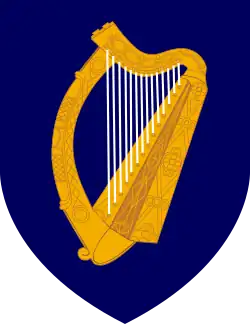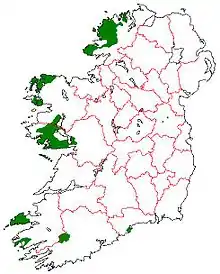| Gaeltacht Act 2012 | |
|---|---|
 | |
| Oireachtas | |
| |
| Citation | No. 34 of 2012 |
| Signed | 25 July 2012 |
| Commenced | Ss. 14–25, on enactment Ss. 1–13 16 April 2013 |
| Legislative history | |
| Bill citation | No. 53 of 2012 |
| Introduced by | Minister for Arts, Heritage and the Gaeltacht (Jimmy Deenihan) |
| Introduced | 19 June 2012 |
| Keywords | |
| Gaeltacht | |

The Gaeltacht Act 2012 (Irish: Acht na Gaeltachta 2012) is an Act of the Oireachtas of Ireland. The Act redefined the traditional Irish-speaking areas or Gaeltacht in the Republic of Ireland on linguistic criteria instead of on geographic areas which had been the position until 2012. While the traditional Gaeltacht boundaries still exist the Act sets out ways where areas outside the Gaeltacht can be formally designated as Irish Language Networks (Irish: Líonraí Gaeilge) and Gaeltacht Service Towns (Irish: Bailte Seirbhísí Gaeltachta).[1][2][3]
In 2016 it was announced that Galway City, Dingle and Letterkenny would be the first recognised Gaeltacht Service Towns, subject to them adopting and implementing approved language plans.[4][5] In February 2018 the Department of Arts, Heritage and the Gaeltacht and Foras na Gaeilge announced that five areas - West Belfast, Loughrea, Carn Tóchair, Ennis and Clondalkin village - were going to be designated as having the first formal Irish Language Networks.[6] [7] Foras na Gaeilge have said that they expect the status to be given to other areas.[8]
The Act also brought the process of the introduction of Language Plans in the Gaeltacht into existence and gave statutory effect to the implementation of the 20-Year Strategy for the Irish Language 2010–2030 by Údarás na Gaeltachta in the Gaeltacht and changed the process by which the board of Údarás na Gaeltachta was elected.
_-_geograph.org.uk_-_1288443.jpg.webp)
See also
- Official Languages Act 2003
- Irish language outside Ireland
- Scottish Gaelic Gaeilge na hAlban / Gàidhlig
- Gàidhealtachd Scottish Gaelic speaking regions in Scotland.
References
- ↑ "Gaeltacht Act 2012". Department of Arts, Heritage and the Gaeltacht (Press release). Retrieved 1 March 2018.
- ↑ Gaeltacht Act 2012, s. 9: Gaeltacht Service Towns (No. 34 of 2012, s. 9). Enacted on 25 July 2012. Act of the Oireachtas. Retrieved from Irish Statute Book.
- ↑ Gaeltacht Act 2012, s. 11: Irish Language Networks (No. 34 of 2012, s. 11). Enacted on 25 July 2012. Act of the Oireachtas. Retrieved from Irish Statute Book.
- ↑ "Dúchas, Daingean Uí Chúis website". Retrieved 1 March 2018.
- ↑ "Letterkenny announced as Gaeltacht Service Town". Donegal Now. Archived from the original on 2 March 2018. Retrieved 1 March 2018.
- ↑ "Ennis Recognised As Líonra Gaeilge". Clare FM. 28 February 2018. Retrieved 2 March 2018.
- ↑ "Irish-speaking areas in north set for official status for first time". The Irish News. 23 February 2018. Retrieved 2 March 2018.
- ↑ "Historical Step for Irish Language Speaking Communities outside of the Gaeltacht". Foras na Gaeilge. 22 February 2018. Retrieved 1 March 2018.
External links
- Gaeltacht Act 2012 from the Irish Statute Book.